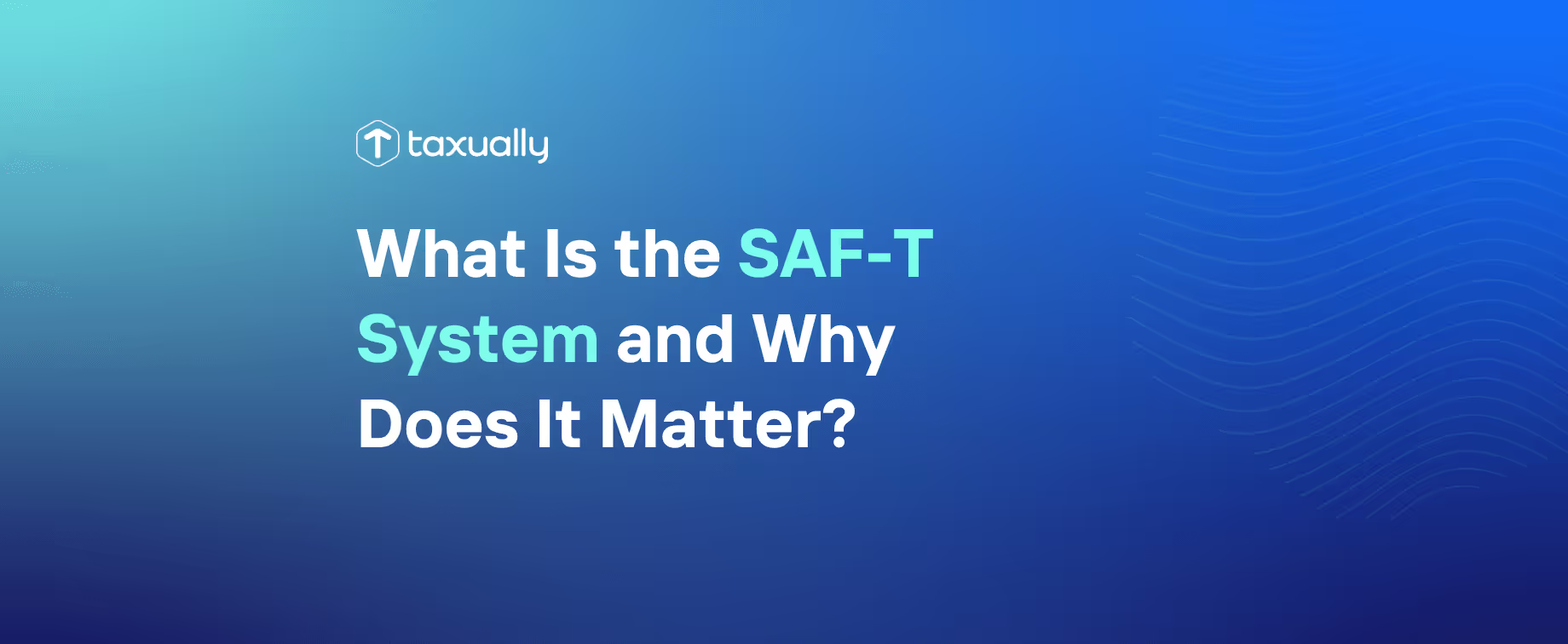Key takeaways
- SAF-T simplifies tax audits by enabling standardized, electronic sharing of financial data between businesses and tax authorities.
- It’s already mandatory in many European countries, with varying local requirements, especially for VAT reporting.
- Businesses benefit from greater accuracy, transparency, and efficiency—but must invest in system upgrades and ongoing compliance efforts.
In today's digital age, businesses are generating vast amounts of financial data on a daily basis. With this increase in data volume comes a greater need for accurate and efficient methods of reporting and auditing financial information. This is where the Standard Audit File for Tax (SAF-T) system comes into play.
What is SAF-T?

The Standard Audit File for Tax, commonly referred to as SAF-T, is an international standard for the electronic exchange of financial and accounting data between businesses and tax authorities. It was developed to facilitate the automated exchange of data, making it easier for tax authorities to audit businesses and ensuring that tax compliance is upheld.
SAF-T was initially introduced in 2005 by the Organisation for Economic Co-operation and Development (OECD) as a means to improve the efficiency and effectiveness of tax audits. Since then, many countries around the world have adopted SAF-T or similar electronic reporting standards.
While SAF-T is not specific to VAT (Value Added Tax) accounting, it's being increasingly used for VAT reporting by tax administrations in the EU and elsewhere. SAF-T can be used as a means to provide detailed VAT-related data to tax authorities in a standardized format. This includes information on sales, purchases, VAT rates, and other relevant data needed for VAT compliance.
SAF-T countries
The following European countries have introduced SAF-T regulations:
The implementation details, requirements, and timelines for SAF-T can vary from country to country, so it's crucial to consult with local tax authorities or professional tax advisors for the latest information and compliance requirements in a specific European country.
The components of SAF-T
SAF-T typically consists of several standardized data files, each containing specific financial and accounting information. The exact structure of SAF-T files may vary from one country to another, but they generally include the following components:
General ledger (GL) data
The GL data file provides an overview of a company's financial transactions, including details on revenue, expenses, and other financial activities. It helps tax authorities gain insight into a company's financial position.
Accounts receivable and payable (AR/AP) data
This file contains information related to a company's accounts receivable and accounts payable. It includes details on invoices, payments received, and payments made. AR/AP data is crucial for tracking outstanding liabilities and receivables.
Inventory data
The inventory data file includes information about a company's stock and inventory levels. It helps ensure that the reported inventory values align with physical stock counts.
Fixed assets data
This component provides details about a company's fixed assets, such as property, machinery, and equipment. It helps tax authorities monitor depreciation and asset values.
VAT (Value-Added Tax) data
For countries with a VAT system, the VAT data file contains information about VAT transactions, enabling tax authorities to verify VAT calculations and payments.
Journals
Journals are records of all financial transactions, including debits and credits. They provide a detailed chronological view of a company's financial activities.
Benefits of SAF-T

Implementing the SAF-T system offers several benefits to businesses and tax authorities alike:
Improved accuracy
One of the primary advantages of SAF-T is the reduction of errors in financial reporting. Automation and standardized data formats reduce the risk of manual data entry mistakes, ensuring that the reported information is accurate.
Efficient auditing
Tax authorities can conduct audits more efficiently and effectively with access to standardized electronic data. This reduces the time and effort required for both businesses and tax agencies during the audit process.
Transparency
SAF-T promotes transparency in financial reporting. Businesses are encouraged to maintain accurate and up-to-date records, which can deter fraudulent activities.
Cost savings
By automating the data exchange process and reducing the need for manual paperwork, SAF-T can lead to significant cost savings for businesses. It also streamlines the auditing process for tax authorities, reducing their operational costs.
Global compliance
As SAF-T is an international standard, businesses that operate in multiple countries can benefit from a unified reporting system, simplifying their compliance efforts.
Implementing SAF-T
Implementing SAF-T requires businesses to adapt their accounting and financial systems to generate the required data files in the standardized format. Here are the key steps for implementation:
Assess compliance requirements
Businesses should first determine the specific SAF-T requirements in their jurisdiction. These requirements may vary by country, so it's essential to stay informed about local regulations.
Upgrade accounting systems
If your current accounting software doesn't support SAF-T, you may need to upgrade or implement a new system that can generate the necessary data files.
Data extraction and transformation
Once the accounting system is ready, businesses need to extract the required data and transform it into the SAF-T format. This often involves mapping data fields to the standard schema.
Testing and validation
Before submitting SAF-T files to tax authorities, it's crucial to conduct thorough testing to ensure data accuracy and compliance. Validation tools can help identify any issues or discrepancies.
Regular reporting
Businesses typically need to generate and submit SAF-T files on a regular basis, such as monthly or quarterly, depending on local regulations. It's essential to establish a consistent reporting process.
Challenges and considerations
While SAF-T offers many benefits, there are some challenges and considerations to keep in mind:
Data privacy and security
Handling sensitive financial data electronically raises concerns about data privacy and security. Businesses must implement robust security measures to protect the integrity of their financial information.
Costs of implementation
Adopting SAF-T may require an initial investment in software and training. Businesses should weigh these costs against the long-term benefits of improved efficiency and compliance.
Compliance variability
SAF-T requirements can vary significantly from one country to another. Businesses with international operations must be prepared to adapt to different compliance standards.
Conclusion
The Standard Audit File for Tax (SAF-T) system is a powerful tool for enhancing financial transparency, accuracy, and compliance. By automating the exchange of financial data in a standardized format, SAF-T benefits both businesses and tax authorities.
While implementation may require effort and investment, the long-term advantages of improved efficiency, reduced errors, and streamlined auditing processes make it a worthwhile endeavor for businesses operating in today's data-driven world. Stay informed about local SAF-T requirements, upgrade your accounting systems, and embrace the future of financial reporting with SAF-T.
Do you need help with your VAT compliance? Book a free call with one of our VAT experts to find bespoke solutions for your business, optimize your VAT costs, and reach millions of new potential customers.
Frequently asked questions
New Year's Day - 1/1/2024Memorial Day - 5/27/20244th of July - 7/4/2024Labor Day - 9/2/2024Thanksgiving Day - 11/28/2024Day after Thanksgiving - 11/29/2024Christmas Eve - 12/24/2024Christmas Day - 12/25/2024
What is SAF-T?
SAF-T (Standard Audit File for Tax) is an international standard for electronically exchanging financial data between businesses and tax authorities to streamline audits and improve tax compliance.
Is SAF-T mandatory in all countries?
No. SAF-T is mandatory in some European countries like Portugal, Poland, Hungary, and France, but each country has its own timeline and requirements.
What kind of data is included in SAF-T files?
Typical components include general ledger entries, accounts receivable/payable, inventory, fixed assets, VAT data, and journal entries.
Does SAF-T only apply to VAT?
No, but it's often used for VAT reporting. SAF-T helps authorities verify VAT records alongside broader financial data.
Do I need special software for SAF-T?
Yes. Your accounting system must be capable of generating SAF-T-compliant files. In many cases, this requires an upgrade or third-party integration.
How often do SAF-T files need to be submitted?
This depends on the country. Submissions can be monthly, quarterly, or on request. Always consult local regulations.
Is SAF-T relevant for small businesses?
Yes. If you're operating in a jurisdiction where SAF-T is required, you must comply regardless of business size.



















